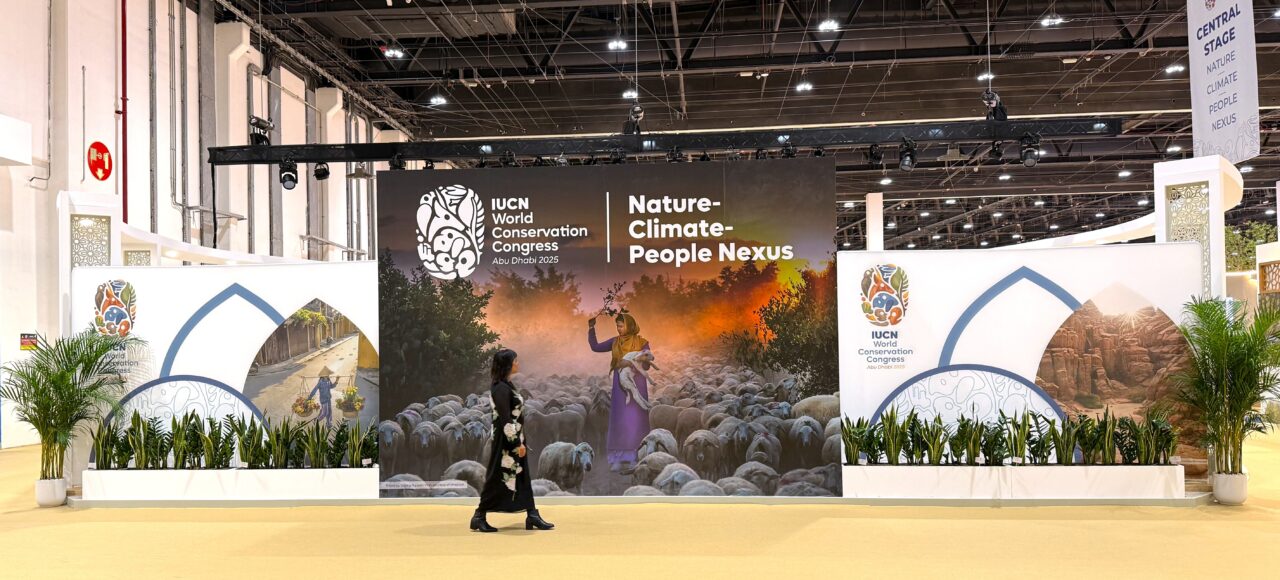From Abu Dhabi to West Africa: Four key take-aways from the IUCN World Conservation Congress
Stepping into the halls of the Africa Pavilion at the IUCN World Conservation Congress on 12 October, I felt the buzz of possibility. Here, a global conservation community was gathered under the theme “Powering Transformative Conservation” to face the triple planetary crisis of climate change, biodiversity loss, pollution and global health.
As someone working mostly in Small Island States and coastal countries in West Africa, it was a powerful reminder that our work on plastic pollution is far from isolated – it sits squarely at the heart of these interconnected crises.
Looking back on a motivating and inspiring experience at the Congress, here are four reflections I’m carrying home – each a thread that links directly to the work we’re doing to tackle plastic pollution in The Gambia, Guinea-Bissau and beyond.
Integrated approaches are vital to tackle the triple planetary crisis
The Congress emphasised that we cannot fight biodiversity loss, climate change or pollution in siloes. These threads are tightly wound together.
One session reminded us that we have only a few years left to meet key 2030 deadlines under the Paris Agreement, the Global Biodiversity Framework and SDGs – and urgent action must be as much about intersectionality as it is about scale.
In our context, this means: tackling plastic pollution isn’t just about “less litter” – it’s about protecting mangroves and seagrasses, safeguarding coastal livelihoods, reducing waste fires that emit greenhouse gases and preventing microplastics from entering marine food chains.
In both The Gambia and Guinea-Bissau, our work is intentionally framed in this way: the NAPs we support are not an “add-on” to waste management, they are a bridge between plastic policy, marine health, waste infrastructure and socio-economic resilience.
My time at the Congress reminded me that this systems-level framing is exactly what will bring us closer to nature-positive economies.
Evidence-based policy: know the flow to change the flow.
At Common Seas, we often say: “We can’t reduce what we don’t measure.”
This belief was reflected across the Congress discourse, with a strong emphasis on data, modelling, leakage pathways and investment logic to transform strategy into action. Using our UN-endorsed Plastic Drawdown tool, we’ve helped countries map plastic flows, identify high-leakage items and design interventions that could reduce pollution by up to 70-80% over ten years.
For example, in The Gambia our analysis determined that the country generates around ~23,000 tonnes of plastic waste annually, with three-quarters leaking into the environment. With this insight, we were able to collaborate with the government and cross-sectoral stakeholders to identify five systems change strategies to reduce leakage by an estimated 86% by 2033.
In Guinea-Bissau, we established that the country was producing 30,000 tonnes of plastic waste per year, and projected that this would rise by 60% without action. Analysing the policy landscape, we prioritised co-designing strategies to target single use bottles and sachets, alongside developing reuse and collection systems.
These models aren’t abstract diagrams, they are practical, actionable guides empowering governments to prioritise interventions, secure budget, and show funders that the benefits of system change are not just environmental but economic.
Discussions held at the Congress reinforced the need to develop policies that are backed by robust evidence, accessible to decision-makers and aligned with financial flows. This aligns perfectly with our approach, leveraging data to inform policies that can be directly translated into implementation.
Partnerships & inclusion: from community voices to national committees
For me the most inspiring talks were about equity, inclusion and leadership – ensuring the voices of women, youth, informal sector workers and Indigenous peoples sit at the decision-making table.
In our work we’ve embedded this from the start. In Guinea-Bissau we partnered with IUCN and delivered a national consultation workshop in June – bringing together 60 participants from various government departments and community organisations representing everything from women’s groups and youth, to market vendors and waste collectors.
The plan also embeds education and behaviour change, building on the work of local partners such as Palmeirinha, Tiniguena, and youth programmes like Captain Fanplastic, which reached nearly 1,800 students last year. This complements Common Seas’ global Education Programme, which provides free lesson packages and teacher training to empower young people as future ocean stewards – with adaptable Global Curriculum Templates now ready for local use in West Africa.
In The Gambia we co-designed the NAP with government, civil society and informal waste-sector representatives – advocating for a just-transition that recognises the contributions and protects the livelihoods of waste pickers as systems evolve.
The Congress reaffirmed: the most durable solutions are those that build from the grassroots, elevate local leadership and reflect the lived realities of those on the frontlines of change.
Finance bridges plans and impact
One message that came through strongly at the Congress was that finance is the bridge between plans and impact – without it, even the best strategies risk staying on paper.
At Common Seas, we know that implementation is just as important as planning. Through new funding from the UK FCDO’s Sustainable Blue Economies Programme, in Saint Lucia and Guinea-Bissau we’re now expanding our work beyond planning – moving into implementation, financing and early pilots.
In these SIDS, we aim to embed local consultants within government departments to drive the NAP rollout and connect actions to national budgets. In Barbados, last year, we placed an Education Officer under a Commonwealth Secretariat incubation grant. This has already been highly impactful in helping to scale our education work regionally.
Sessions on conservation finance and nature-positive economies at the Congress reinforced that the plastics transition must be financed with the same ambition as climate adaptation or biodiversity restoration. Regional models, blended finance, producer responsibility schemes, and bankable pilots were highlighted as game-changers.
This is reflected in an initiative we are currently working on in partnership with the Indian Ocean Commission (IOC) to explore the potential of a regional approach to Extended Producer Responsibility (EPR) for their member states. When tailored to local context, a regional approach to EPR could help achieve economies of scale, overcome logistical barriers, and enhance SIDS’ market power. But it could also provide a secure, flexible source of funding for plastic management and legacy plastic remediation.
Looking ahead, this pilot could serve as a financing and coordination model for countries like The Gambia and Guinea-Bissau – using shared frameworks, pooled data, capacity building, and cross-border scale as key principles.
Ambition needs partnership to become action.
My day at the Africa Pavilion brought home a simple truth: ambition matters, but partnership bring plans to life. At Common Seas we are fortunate to work with governments in The Gambia and Guinea-Bissau that are willing to take vital steps from discourse to action.
If we remember just one thing from the Congress it is this: combining national action (NAPs) with regional collaboration and strong partnerships enable Africa’s coastal nations to lead the transition toward a just and circular economy – turning ambition into action.
As our journey continues, I’m more energised than ever to embed these four reflections into the next chapter of our policy work at Common Seas.
With local partners who bring expertise and lived experience – and with funders who recognise that plastic pollution is not a side-issue but is central to climate resilience, ocean protection, human health and equity – we can build a future freed from plastic.


